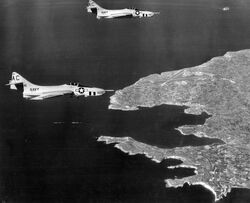
U.S. Navy Grumman F9F-8P Cougars from VFP-62, flying from USS Saratoga (CVA-60), over RAF Hal Far in 1958.
Data[]
| Category. | Statistic. |
|---|---|
| Location. | Malta. |
| Opened in. | 1929, but heavly upgraded in 1942. |
| Closed in. | 1979. It is now under an industrial estate, a Playmobile factory, a WW2 museum and a refugee camp. |
| Operated by. | Royal Navy (1929-1945), RAF (1945-1978), Maltese air force (1978-79) local civil authorities and several firms factories (1979-today) |
| Owned by. | British MoD (1929-78), Maltese MoD (1978-79) local civil authorities (1979-today) |
| Outside link. | https://en.wikipedia.org/wiki/RAF_Hal_Far, https://en.wikipedia.org/wiki/%C4%A6al_Far, http://www.ronaldv.nl/abandoned/airfields/MT/malta.html, https://en.wikipedia.org/wiki/%C4%A6al_Far, http://www.wow.com/wiki/RAF_Hal_Far, https://images.search.yahoo.com/search/images;RAF+Hal+Far&fr=yset_chr_cnewtab, http://www.forgottenairfields.com/malta/island-of-malta/raf-hal-far-hms-falcon-s389.html and https://en.wikipedia.org/wiki/RAF_Hal_Far. |
History[]
The RAF Hal Far airfield was the first permanent airfield to be built on Malta. It was opened on 1 April 1929 as HMS Falcon, a Royal Navy stone frigate, and was used by Fleet Air Arm crews. It was transferred to the Maltese Government and redeveloped from January 1979. It is now closed and one of its runways is used by drag racing enthusiasts. The second runway is now a road leading to an industrial estate which was developed recently.
World War 2[]
During the Second World War, Hal Far airfield was one of the main targets for the Luftwaffe and the Regia Aeronautica and suffered several bombings during the blitz. On July and August 1940 in the beginning of the Siege of Malta, the Italian air-raids managed to damage several squadron aircraft. Hal Far had been the first Maltese airfield to be bombed on 11 June 1940. During this period, 2,300 tons of bombs were dropped on the airfield, in which a total of 30 were killed and 84 were injured. Various officers and Maltese civilian employees were awarded the George Cross, George Medal and other awards for their courage and bravery in the face of enemy action and the air station never fully closed after the raid.
The Air Sea Rescue and Communications Flight, which had originally formed at Hal Far in March 1943, but which moved to Ta' Qali the following September, returned to Hal Far in March 1944.
A different kind of event occurred in when British Prime Minister Winston Churchill and US President Franklin D. Roosevelt came to Malta in anticipation of the Malta Conference with Soviet Premier Joseph Stalin in the January of 1945. To deter any possible enemy attack, nine Spitfire IXs of N° 1435 Squadron, and six Mosquito night fighters of N° 256 Squadron, deployed to Hal Far from Grottaglie and Foggia respectively, two of the Mosquitos escorting the Prime Minister's Avro York transport aircraft outside Malta and into Luqa airfield on 29 January. All aircraft remained at Hal Far into early February until all the VIPs had left.
Cold War[]
After the evolution from piston to jet engines in the 1950s, the airfield had to be closed for three weeks for the resurfacing of the runways. The airfield started housing various training camps by the UK-based Royal Naval Volunteer Reserve (RNVR) Air Divisions. Several units used HMS Falcon for these annual summer camps, which started in 1950, stopped in 1951, and continued from 1952 to 1956. During 1958 Hal Far was the proving base for the world's first assault helicopter squadron.
After being used by the Royal Navy, the Hal Far airfield was returned to the RAF for a short period of time in the mid and 1960s, and the last squadron was disbanded on 31 August 1967. Between March 1967 and September 1978 the airfield served as a base for the American aircraft maintenance company M.I.A.Co.
Civil history[]
Airport[]
During the resurfacing of Luqa's runways, all civilian and military flying was transferred to Hal Far until Luqa became operational again.
Closure[]
With the transfer of the airfield to the Maltese Government, who planned to convert Hal Far airfield into an industrial area, MIACO was asked to vacate its hangars and offices by September 1978. The control tower and the officer's quarters are still intact, together with a few Nissen huts. The kitchens and mess halls, the electricians and radio section cabin are still standing, but in a dilapidated state.
Modern usage[]
On the 5th of August 2010, the Employment & Training Corporation inaugurated an Underground Sick Bay which lies within the premises. This has been turned into a museum emphasising the period between 1923-1945. Other parts of the airfield such as the hangar have been transformed into a refugee camp for illegal immigrants.
Ħal Far (English: Rat's Town), is one of the main industrial estates in Malta. It is at the southern extreme of Malta, between the localities of Birżebbuġa, Safi and Żurrieq.
In the past, Ħal Far housed the RAF Hal Far airfield, which was known as HMS Falcon when in the service of the Royal Navy. The runway can still be seen and driven on, leading the Maltese to use for drag car racing. Parts of the airfield including the hangar have been converted into accommodation centres for refugees and asylum seekers.
In this area, one can also find the historical Ħasan Cave, the Wardija Tower and the Playmobil Park, the world's second largest Playmobil factory, which makes over 2 million Playmobils a week and offers tours to the public.